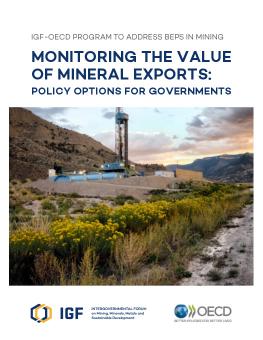
Monitoring the Value of Mineral Exports
Policy options for governments
This practice note aims to increase policy-makers knowledge of the process of determining the value of exported minerals and support informed, risk-based government decisions on how best to monitor the value of mineral exports.
In the mining sector royalties and income taxes are usually levied on the price of the mineral, multiplied by the volume. The price might be the actual sale price received or the relevant quoted price, if there is one. Consequently, government revenue depends on mineral products being priced and measured accurately.
This practice note aims to increase policy-makers' knowledge of the process of determining the value of exported minerals. The focus is determining the value (or quality) of mineral exports, not the quantity. While there is a risk that companies may underestimate both, verifying the value of minerals is more complex and requires more technical expertise. Additionally, most governments have some measures in place to verify quantity—for example, draft surveys to calculate the weight of a ship carrying minerals for export—whereas the skills, expertise, and facilities to monitor mineral value are lacking.
Having laid the foundation, this practice note outlines three main policy options for improving government oversight of mineral product export valuation, including:
- direct measurement of mineral value,
- monitoring companies' own mineral export valuation processes, and
- a hybrid approach.
The goal is that policy-makers will be equipped to make informed, risk-based decisions on how best to monitor the value of mineral exports.
Participating experts
You might also be interested in
Artisanal and Small-Scale Mining of Critical Minerals
This report examines the potential for artisanal and small-scale mining (ASM) to take an expanded role in the global supply of critical minerals.
Leveraging Digital Infrastructure for Mining Community Resilience
This report explores the socio-economic impacts and potential of new technologies in the mining sector.
Navigating Global Sustainability Standards in the Mining Sector
This brief examines the latest developments and trends in responsible mining standards and voluntary sustainability initiatives.
IGF Case Study: Decarbonization of the Mining Sector
Case studies from Chile, Indonesia, and South Africa that delve into the role of the mining sector in efforts to reduce greenhouse gas (GHG) emissions.